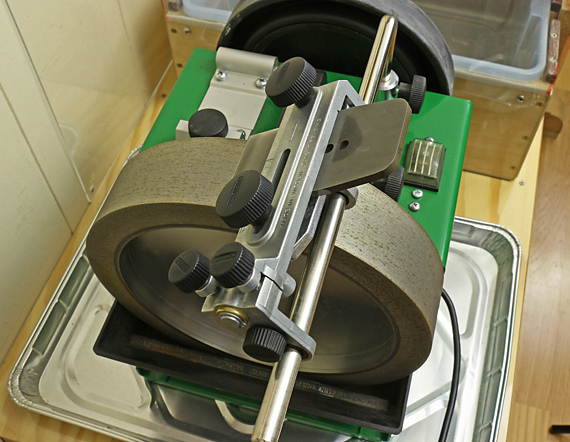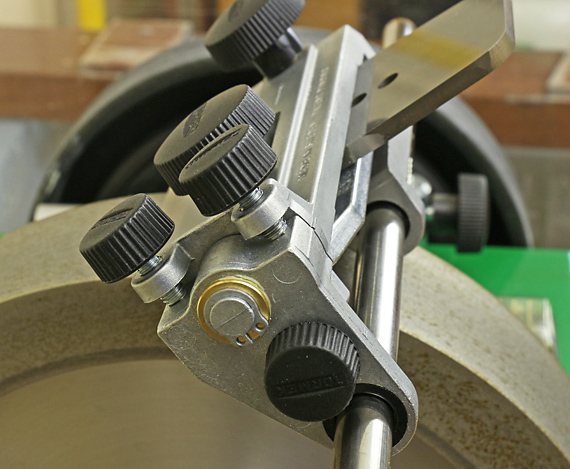
For those not familiar with the Tormek grinder, the SE-77 jig, an upgrade over the older SVH-60, holds the blade and slides onto the guide bar, where it rotates to present the blade edge to the grindstone in a very consistent manner. The niftiest features of the SE-77 are its ability to reliably put a controlled amount of camber on a plane blade, and to microadjust the lateral angle of the blade edge to the stone.
The SE-77 has a sturdy build. The left clamp screw slides to adjust the width between the two clamp screws. This more securely holds a wide range of blade widths. There is an end stop on the right side that squarely registers the right side of the blade into the jig, which is useful for blades with parallel sides.
The pair of small thumbscrews, shown in the foreground of the photo below, controls the two special functions of the jig.

To microadjust the lateral angle of the blade edge against the stone, you back off one of the screws and advance the other the same amount. This is much more reliable than shifting and reclamping the blade in the jig.
To camber the blade edge, you loosen both microadjust screws. This creates a pendulum motion about the small stem. (See the photo: the small stem has a brass washer and external snap ring on its end.) With this pendulum motion, you can guide a controlled amount of camber onto the blade edge. The system works very well, though you do have to blend a gradual arc. A too-heavy touch can create a shallow V-point edge instead of a nice smooth camber.
Another welcome feature of the SE-77 is the design of the lower jaw of the blade clamp, which gives a good grip on Japanese chisels (hallelujah!), even onto the shank.
At $66, the SE-77 is not cheap. Having used the Tormek for a many years for grinding – very little on the leather honing wheel – this new jig has been a worthwhile upgrade.
Dear readers, I hope this series on blade camber has been helpful. As always, what I write is born of “the sawdust and shavings of my shop.” These are the techniques and approaches that work for me as I make things. I welcome your ideas and comments.
Rob


Rob,
Thanks so very much again for taking the time to write your posts and provide such wonderful and helpful information !
Background:
After briefly chatting with one of fine gentlemen over at Woodcraft (Walpole !), he is of the opinion that the Tormek in general takes significantly longer to to grind when compared to a standard slow speed grinder (with a decent aftermarket plate / jig), such as the Rikon with the Wolverine or Veritas attachments.
Question:
Do you find that it takes significantly longer using the Tormek ?
And if so, would you say that the trade off is precision ? Or anything else ?
Side note: I am personally just looking to get set up for grinding bench chisels and plane irons before moving to the stones.
Thanks !
Sincerely,
Christopher Valois
FYI: The Hammer A3-31 that I purchased after reading your multiple previous posts is INCREDIBLE !
Hi Chris,
Yes, the Tormek is significantly slower than a 1750RPM grinder. The trade-off for me is comfort and control – I’m just not a fan of sparks in my shop. The Tormek jigging system is also excellent.
Soon I will be reviewing an aftermarket CBN wheel for the Tormek. If you are going to use a 1750 grinder, I suggest considering a CBN wheel from http://www.woodturnerswonders.com
By the way, I have little use for the Tormek leather wheel. It is handy for some knives and carving tools but little else for me.
Unfortunately, the price of the Tormek is more outrageous than ever. I got mine around 15+ years ago.
I’m glad the A3-31 is working out for you.
Rob
Hi Rob, I have really enjoyed reading these posts on camber, very helpful for many of us. For an A2 smoothing plane iron, would you effect a camber on diamond stones only and if so what grade would you start on? Or would you use the tormek anf finish on a medium or fine stone? Just wondering on the optimal approach to create a very slight camber for smoothing without leaving plane tracks…..something I struggle with usually having to simply sand those out!
Many thanks,
Hi Stephen,
For a bevel-down smoothing plane, especially if it has a high-angle frog such as 55°, you really need very little camber. The shavings are going to be only about a thou; two thou would be fairly thick for smoothing. So the camber is probably just a couple thou.
To grind that little bit of a camber on the Tormek (or any grinder or even a coarse stone of whatever sort) makes it very easy to overdo it. So I suggest introduce the camber on a medium stone, say a 1200 grit waterstone, a Japanese blue stone, maybe even a 4K waterstone, or as I now prefer, a diamond stone, 9µ. Try making less than you think you need, check it with a straightedge like that little aluminum square. Don’t wait until you can see the camber grossly by eye – you’ll likely put in too much.
You might even try just making a straight primary bevel – oh maybe barely leaning on the sides, or just let that happen naturally. Then, add the camber “intentionally” when you are honing the secondary bevel. It’s a bit slower but it will almost surely prevent you from overdoing the camber.
If it’s a bevel-up smoother (12° frog) you’ll need lots more camber (as observed viewing normal to the blade face). So, in that case, I’d start the camber early on, at the grinder or coarse stone.
The bottom line is how the plane performs. Get it about right once. Take out the blade and look at the camber against the straightedge. Remember that picture.
I know how much cayenne pepper is enough, too little, and too much on my food. Though there is not much margin for error, I’ve never measured it, of course. The same goes for camber in the plane blade. Relate the appearance to the performance. Once you do, you’ll find your own comfortable method to create the camber.
Let me know how it goes if you can.
Rob
Have you ever tried to camber a plane blade using the veritas MKII camber roller attachment? I use the MKII whenever I sharpen, but find it difficult using the camber roller. Any ideas?
I also have the Worksharp 3000 along with diamond and water stones, but do you know anyone who bought the attachment to use tormek jigs? Wondering if it would be possible to camber using the tormek jig you use on a work sharp? The attachment I’m referring too, is a bar that would hover over the sanding disk. You slide the jigs onto bar as you would the tormek bar.
Hi Trevor,
I do have the MKII camber roller. It works but I prefer to freehand when refining the blade camber with bench stones. It is a good tool though.
Before you spend too much $$$, give it a try freehand adding some camber using your bench stones, especially the diamond stones. My low tech honing “guides” can help set the angle “into your hands.”
See: http://www.rpwoodwork.com/blog/2008/10/28/honing-guides/
Work instinctively, correct from there, and I’ll bet you’ll soon surprise yourself with the results.The error most will make is to put too much camber on a smoothing plane blade. No problem; that’s easy to correct. As you resharpen and remove the dullest part of the blade, you’ll automatically be removing some of the excess camber.
I looked at Worksharp’s video on the Tormek-type bar for their machine.
https://www.woodcraft.com/products/work-sharp-3000-tool-bar-attachment
Looks good. I did a mockup to see how the SE-77’s camber function would present the blade edge to a flat surface such as the Worksharp disc. I believe it will work. I think you’ll like the SE-77.
There are lots of options that work.
Let me know how it goes if you get a chance.
Rob